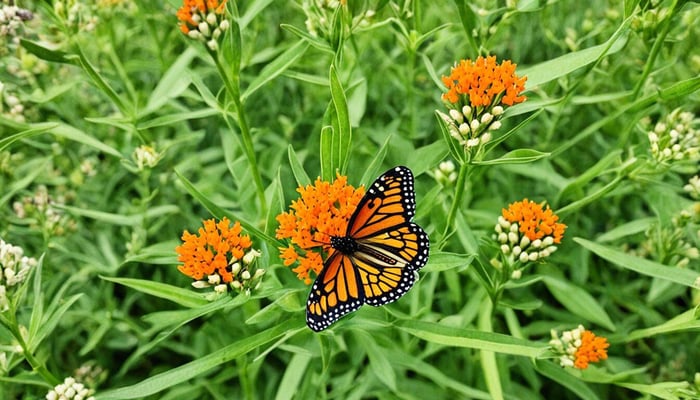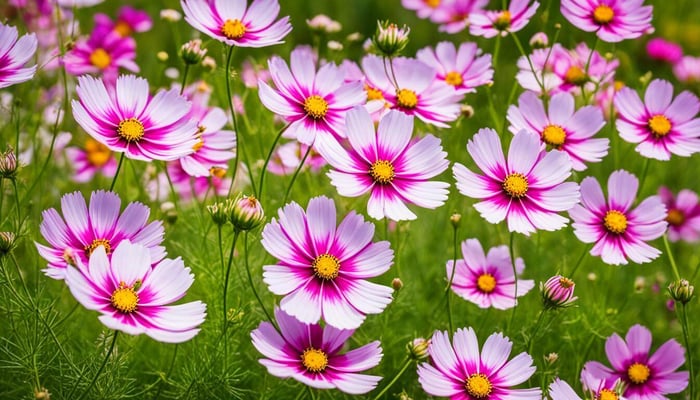Imagine your garden bustling with life, an array of colors fluttering as monarch butterflies dance from flower to flower. This picturesque scene is closer to reality than you may think, and it starts with starting milkweed from seed. Butterfly Milkweed, a crown jewel in a butterfly garden, not only captivates with its fiery blooms but also serves as a lifeline for these majestic creatures. Today, we unveil the surprisingly straightforward process of growing Butterfly Milkweed from the comfort of your backyard.
We are on the brink of a gardening seed revolution, where the simple act of native plant cultivation extends beyond aesthetics, nurturing our local ecosystems. Let's embark on a journey together; from hand-picking the perfect flower seeds to witnessing the first signs of germination, we guide you every step. Because when it comes to conservation, every milkweed seed sown is a hope planted for a brighter, more vibrant tomorrow.
Key Takeaways
- Selecting high-quality seeds is the foundation of a thriving butterfly garden.
- Understanding the milkweed's lifecycle aligns our planting schedule with nature's rhythm.
- The germination process is not merely planting; it's an act of rewilding our urban landscapes.
- Each Butterfly Milkweed grown contributes to the monumental effort of monarch conservation.
- Joining forces with nature, our gardens become havens for biodiversity and beauty.
Butterfly Milkweed Seeds
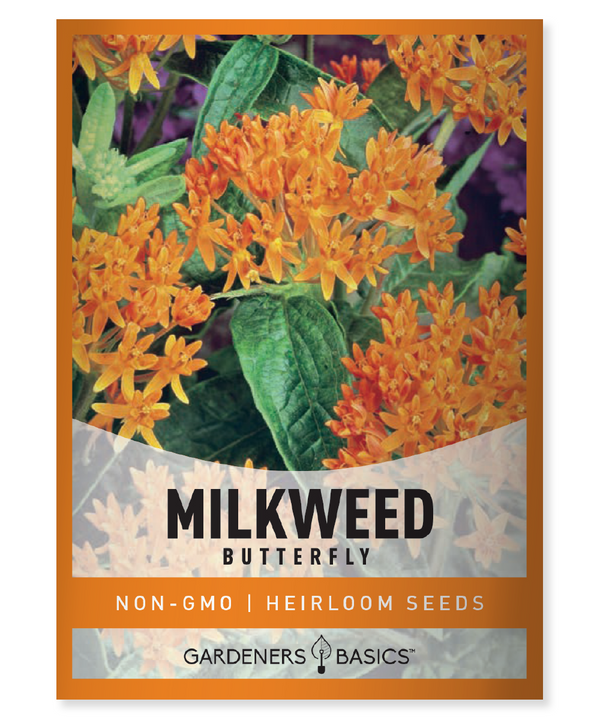
$2.49
Butterfly Milkweed Seeds - Heirloom, Non-GMO, Non-Hybrid, Open-Pollinated - Perfect for Pollinator Gardens Grow a vibrant and essential addition to your garden with Butterfly Milkweed seeds. Known for their stunning orange blooms, Butterfly Milkweed (Asclepias tuberosa) is a hardy perennial… read more
Butterfly Milkweed General Info
- Days till maturity: Butterfly milkweed typically reaches maturity in 70 to 90 days after the seeds germinate.
- Planting depth: Seeds should be planted 1/4 inch deep in the soil.
- Plant spacing: Space plants 18 to 24 inches apart for full growth.
- Days to germination: Seeds usually germinate in 10 to 30 days, depending on soil temperature and conditions.
- Indoors or Direct Sown: It's recommended to start the seeds indoors 8 to 10 weeks before the last frost date, then transplant outdoors. However, direct sowing is also effective, especially in areas with longer growing seasons.
- Full Sun or Partial Shade: Butterfly milkweed thrives in full sun but can tolerate partial shade.
- When to harvest: While typically grown for its flowers and to attract butterflies rather than for harvest, seed pods can be collected in late summer or fall when they begin to dry and open.
- How tall does the plant get? Butterfly milkweed can grow to be 2 to 3 feet tall.
- How wide does the plant get? The plant can spread out to about 1 to 2 feet wide.
- Native: Yes, it is native to North America, especially in prairies, meadows, and open fields.
- Family: Butterfly milkweed is part of the Asclepiadaceae family, known for its milk-producing plants.
Understanding Butterfly Milkweed and Its Importance
In the heart of pollinator-friendly gardens, the bright hues and enriching presence of Asclepias tuberosa, commonly known as Butterfly Milkweed, stand out as a vital contributor. This perennial is not just another ornamental addition to our garden spaces; its myriad of benefits secure a pivotal role in nurturing and maintaining a thriving ecosystem.
The Role of Butterfly Milkweed in the Ecosystem
Recognized for its utility and beauty, Butterfly Milkweed is an ecological powerhouse. As a crucial host plant for monarch butterflies, it offers a safe haven for larval growth, ensuring the continuation of their species. The benefits of this plant extend to a diversity of pollinators attracted to its nectar-rich flowers. Let's delve deeper into the symbiotic relationships fostered by this native flora:
- Monarch Butterflies: The caterpillars exclusively feed on the leaves containing vital nutrients and protective toxins.
- Bees and Hummingbirds are drawn to the nectar, which sustains these vital pollinators and aids in the broader pollination process.
- Native Fauna: It offers lodging and food, supporting a range of species that contribute to biodiversity.
This chain of interactions underscores the Butterfly Milkweed's benefits, which are fundamental in crafting preservation strategies for local wildlife and broader ecological systems.
Why Gardeners are Choosing to Plant Milkweed
Amid growing ecological concerns and a dedication to sustainability, gardeners nationwide are turning to plants like Butterfly Milkweed for their low-maintenance characteristics and proficiency in building pollinator-friendly gardens. Gardeners Basics and other advocates have shed light on the undeniable assets of this plant:
| Quality | Benefits |
|---|---|
| Drought Tolerance | Adapts to various climates, requiring minimal irrigation once established. |
| Low Maintenance | Thrives without the need for fertilizers or pesticides, making it an environmentally friendly choice. |
| Yearly Blooming | Offers an annual spectacle of vibrant orange to pink flowers that enhance garden aesthetics. |
By integrating Butterfly Milkweed into their garden plans, enthusiasts are beautifying their grounds and participating in a movement to sustain and nourish the species that rely on Asclepias tuberosa. It's a winning scenario for gardeners, pollinators, and the planet.
Preparing to Plant Your Milkweed Seeds
As we turn the pages of our garden planning books towards a new chapter, we recognize the importance of selecting milkweed seeds with the utmost care. Partnering with venerable sources like Gardeners Basics is essential to ensuring that your Butterfly Milkweed begins its journey from a pedestal of quality. Let's outline the fundamental steps to translate your dedication into blossoming success.
Choosing seeds that are healthy and viable is the cornerstone of a garden that beckons to both beauty and biodiversity. - Gardeners Basics
When devising your planting schedule, consider that timing is a symphony where you, the gardener, are the conductor. Certain climatic melodies call for early rehearsals, while others demand a later commencement. The regional climate patterns will be your guide in scheduling the sow, harmonizing with the specific growth cycle of Butterfly Milkweed.
Let us lay the groundwork before nestling your chosen seeds into the earth. Below, we present a meticulously crafted table encapsulating the elemental considerations for preparing your milkweed's cradle:
| Preparation Step | Description | Timing |
|---|---|---|
| Site Selection | Choose an area brimming with sunshine, mimicking the open prairies native to Butterfly Milkweed. | Early Spring |
| Soil Preparation | Ensure well-drained soil, perhaps amended with organic matter, setting a stage ripe for growth. | 1-2 weeks before planting |
| Seed Stratification | Simulate winter conditions to awaken the seeds, a crucial step for germination. | 6-8 weeks before the last frost |
With the portrait painted and the palette set, our next motion is to gracefully transfer the milkweed seeds to their new abode, fostering an environment ripe for germination and growth. And as we embed each seed, we weave the fabric of a future teeming with fluttering wings and vibrant blossoms.

How To Grow Butterfly Milkweed From Seed: Step by Step
Embarking on the journey of germinating milkweed seeds is rewarding and essential for creating a supportive habitat for monarch butterflies. Let us walk you through the key stages that will maximize the promise of your future Butterfly Milkweed.
Choosing the Right Soil for Milkweed
In the quest for optimal soil conditions, replicating the Butterfly Milkweed's natural habitat is imperative. A well-draining soil mix that’s not too rich is the goal, as this mimics the arid plains where these plants naturally flourish. Sand or loamy soils with a pH between 6.0 and 7.0 provide the ideal texture and acidity for milkweed growth.
Seed Stratification: Preparing Milkweed Seeds for Germination
The secret to unlocking the life within milkweed seeds lies in the seed stratification process. This entails a cold and moist period to break the seed's dormancy—a mandatory step for successful germination results. To stratify milkweed seeds, mix them with slightly damp sand and store them in a refrigerator for 30 days to simulate winter conditions.
Sowing Milkweed Seeds Indoors
Initiate the planting indoors 6-8 weeks before the last predicted frost. Sow the stratified seeds in individual pots or a tray with seed-starting mix, lightly covering them with soil. Water gently and maintain a temperature of about 70°F to encourage growth. The magic of nature will soon be evident with sprouting seedlings ready to be nurtured into vibrant, butterfly-attracting plants.
- Maintain moist, not waterlogged, soil for the seedlings.
- Provide ample sunlight or a grow light to simulate the sun's warmth.
- Watch for germination, which typically begins within 10 to 15 days.
After the seedlings emerge and establish a strong set of leaves, they will be ready for the next step—hardening off and transplanting to their final outdoor location. This step-wise guidance ensures that your efforts in starting Butterfly Milkweed from seed culminate in the lush growth of a butterfly oasis in your garden.
Milkweed Seeds For Monarch Butterflies | 4 Variety Pack
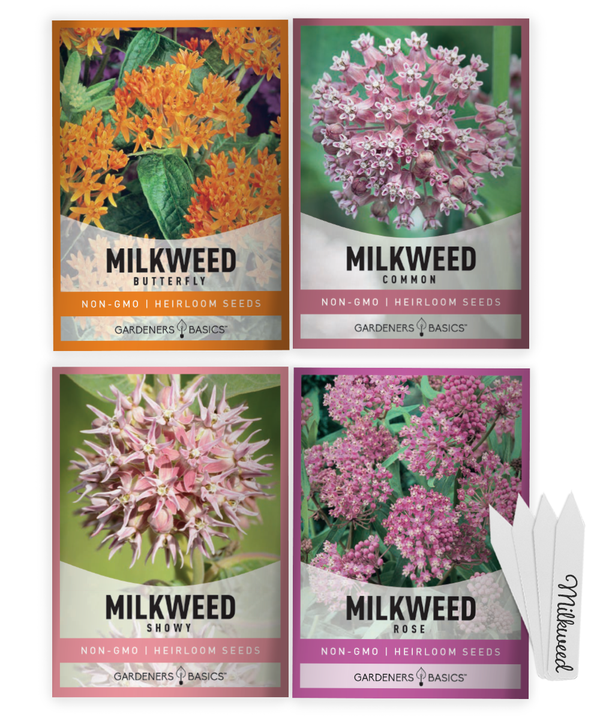
$9.95
Milkweed Seed Assortment For Planting – 4 Stunning Varieties to Attract Monarch Butterflies and Beautify Your Garden Transform your garden into a thriving paradise with our Milkweed Seed Assortment for Planting. This exclusive collection features four exquisite Milkweed varieties -… read more
Tips for Transplanting Milkweed Seedlings Outdoors
With your milkweed seedlings sprouting and gaining strength, transplanting them into the great outdoors is the next critical phase in your milkweed garden setup. Mastering the technique of transplanting seedlings ensures your plants' survival and promises a lusher, more welcoming home for butterflies. We'll explore the optimal time for moving your seedlings outside and the best practices for hardening off plants, creating a seamless transition from the safety of indoors to the natural environment.
When to Transplant Milkweed Seedlings
Timing is essential in the transplantation process. The ideal period for relocating your milkweed is after the last frost when the soil has warmed up. Ensuring outdoor temperatures consistently remain above 50°F (10°C) provides the seedlings with a conducive environment for growth. A good rule of thumb is to wait until your seedlings are about 3 inches tall with a few sets of true leaves, ensuring they're robust enough for the move.
How to Acclimate Milkweed Seedlings to the Outdoors
Hardening off is a gradual acclimation process. Here's how to ensure your milkweed seedlings adapt properly:
- Start about 7-10 days before transplanting. Place seedlings outdoors in a shaded, sheltered area.
- Increase their exposure to sunlight by a couple of hours each day, moving them eventually into direct morning sunlight.
- Protect from strong winds and extreme temperatures by bringing them indoors if necessary.
- After a week, seedlings should be exposed to full morning sunlight and partial afternoon shade.
- Ensure their soil remains moist during the hardening-off phase to prevent undue stress.

Your milkweed seedlings will be ready for the final move following these steps. When transplanting, dig holes twice the root ball's size, space them about 18 inches apart to give them ample room to grow, and align them with the same depth they were growing in their containers. Water them thoroughly after transplanting to help settle the soil and reduce transplant shock.
| Action | Description | Benefit |
|---|---|---|
| Digging Holes | Make holes twice the size of the root ball. | Ensures roots have enough space to spread. |
| Spacing | Plant milkweed about 18 inches apart. | Allows for sufficient airflow and growth. |
| Watering | Water deeply after transplanting. | Helps establish roots in the new location. |
Following these detailed steps, your journey from sowing seeds indoors to creating a flourishing outdoor milkweed garden setup is now within reach. Each knowledgeable action you take is an investment in the health and beauty of your future butterfly sanctuary.
Maintaining and Caring for Your Milkweed Plants
As dedicated gardeners in perennial gardening, we understand that our efforts extend beyond the planting process. Once your Butterfly Milkweed has taken root, milkweed plant care becomes essential in fostering an environment where these crucial perennials can thrive. A well-maintained garden flourishes with beauty and becomes a stronghold for sustaining local wildlife, including the cherished monarch butterflies.
Watering practices for Butterfly Milkweed should be moderate; these resilient plants tolerate some drought once established but appreciate consistent moisture, especially during their first growing season. Fertilization is typically unnecessary, as Butterfly Milkweed naturally occupies poor soil—an overabundance of nutrients can impede its bloom production. Instead, add a layer of mulch to conserve moisture and control weeds.
Vigilance is key when it comes to pest management. Aphids and milkweed bugs can occasionally be found enjoying the sap of your plants. While reaching for chemical solutions is tempting, remember that your garden is also a sanctuary for butterflies. Opt for gentle organic pest controls or a soft spray from a hose to dislodge unwanted visitors, ensuring the safety of your pollinators.
Pruning is not often necessary but can be done to shape your milkweed or remove any brown, spent blossoms, encouraging further flowering. As summer wanes, allow some seed pods to mature if you wish to collect seeds for next year's planting or to naturally increase your milkweed population—a technique well-known in perennial gardening.
Lastly, understanding the perennial nature of your Butterfly Milkweed will guide you in their seasonal care. In autumn, the plants will die back; this is normal. At this time, it's wise to cut the stems back to 6 inches to help maintain plant health and prepare for a vibrant return in spring. Here's a table that encapsulates the key aspects of milkweed care:
| Aspect of Care | Techniques | Benefits |
|---|---|---|
| Watering | Moderate watering, more frequent during establishment | Stimulates strong root development |
| Fertilizing | Typically unnecessary; consider mulching instead | Promotes natural growth and flower production |
| Pest Management | Organic controls; physical removal | Protects the garden's ecosystem and pollinators |
| Pruning | Optional for shape; remove spent blossoms | Encourages new growth and potential blooms |
| Seasonal Care | Autumn dieback management; cut stems back to 6 inches | Prepares plants for a robust spring return |
In practicing these carefully considered strategies, we're not only cultivating a garden—we're stewarding a living, breathing ecosystem. As perennial caretakers, we have the unique privilege of witnessing the harmonious ballet of nature's resilience and beauty. And, as each year passes, your milkweed garden will continue to flourish, standing testament to the power of mindful, perennial gardening.
Conclusion - How To Grow Butterfly Milkweed From Seed
As we reflect on the journey of Milkweed propagation, we're reminded that our gardens are more than just spaces of beauty; they're vital components of sustainable gardening. Sowing a seed extends far beyond individual pleasure, branching into the grander gardening scheme for wildlife. By fostering Butterfly Milkweed, we not only brighten our own plots but also contribute to the health of local ecosystems and preserve biodiversity.
Key Takeaways from Growing Butterfly Milkweed
The process of growing Butterfly Milkweed from seed is an enriching experience that combines the delights of gardening with the responsibilities of environmental stewardship. Each step, from careful soil preparation to nurturing young seedlings, reinforces the importance of patience, care, and attention to detail. More than this, our efforts to embrace Milkweed propagation yields a generous reward: a garden abuzz with life and a haven for monarch butterflies, a cherished symbol of nature's delicate balance.
Encouraging Biodiversity with Your New Milkweed Garden
Within each Milkweed garden lies the potential to be a microcosm of biodiversity—each plant a thread in the intricate web of life. We, as gardeners, have the power to shape these threads into a tapestry of flourishing habitats that support an array of wildlife. Culturing Butterfly Milkweed and other native plants is more than a pastime; it profoundly contributes to creating a resilient and diverse environmental landscape for future generations to cherish.
In the panorama of sustainable gardening, we find joy and pride in witnessing the fruits of our labor—the Butterfly Milkweed's blooming and its winged visitors' arrival. This natural celebration of color and life is a testament to the meaningful impact we can have when we align our gardening practices with the needs of our local ecosystems. Our shared effort in gardening for wildlife is indeed a triumph of the human spirit intertwined with the persistence of nature.
Wildflower, Perennial, & Annual Flower Seed Kit | 35 Variety Pack
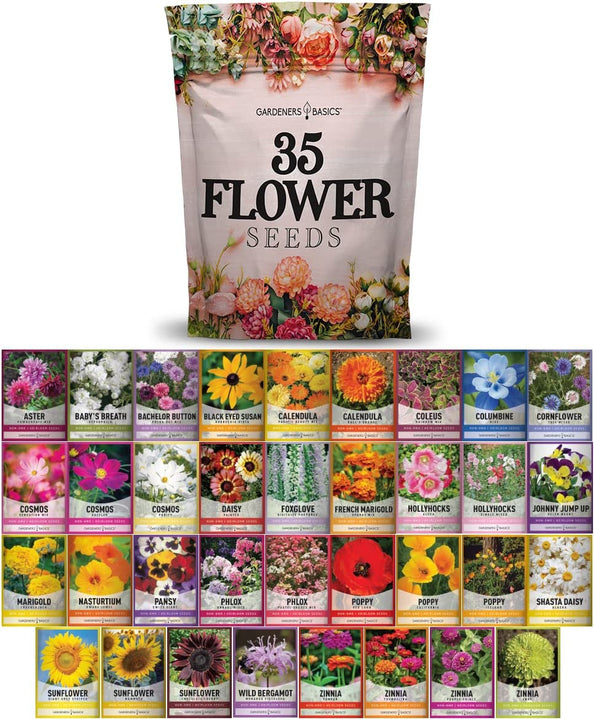
$29.95
$49.95
35 Flower Seeds Variety Pack – Heirloom, Non-Hybrid, Non-GMO, Open-Pollinated – Perfect for Pollinator-Friendly Gardens Transform your garden with our 35 Flower Seeds Variety Pack, offering a stunning and diverse selection of heirloom, non-hybrid, and non-GMO seeds. Each variety in… read more
FAQ Butterfly Milkweed Seeds
What are the benefits of growing Butterfly Milkweed in my garden?
Butterfly Milkweed, scientifically named Asclepias tuberosa, plays a crucial role in the ecosystem by serving as a host plant for monarch butterflies and providing nectar for various pollinators. By cultivating this native plant, you're contributing to biodiversity and supporting important pollinator populations, vital for a healthy environment.
How can I start growing Butterfly Milkweed from seed?
Starting Butterfly Milkweed from seed involves a few key steps: selecting high-quality seeds, performing seed stratification to mimic winter conditions for germination, and sowing the seeds in well-draining soil indoors. Following these steps carefully is essential to successfully grow Butterfly Milkweed and enjoy its vibrant flowers in your garden.
Why should I consider native plant cultivation, specifically Butterfly Milkweed, for my garden?
Native plant cultivation is crucial for maintaining local ecosystems. Butterfly Milkweed is a significant contributor as it's not only a low-maintenance plant but also has a high impact in attracting and sustaining pollinator populations, including the endangered monarch butterfly. It helps create pollinator-friendly gardens and enhances your local environment's overall health and diversity.
Where can I find quality milkweed seeds for planting?
For the best chance of successful germination and healthy plant growth, it's important to select milkweed seeds from reputable sources. Companies like Gardeners Basics offer various milkweed seed options and are committed to conservation efforts, ensuring you receive good seeds for your garden and the environment.
When is the ideal time to start milkweed seeds indoors?
Starting milkweed seeds indoors should be timed with your regional climate and the natural growth cycle of the Butterfly Milkweed. Typically, seeds should be stratified about 1-2 months before the last frost date in your area and then sown indoors. This timing ensures your seedlings are ready to be transplanted outdoors when conditions are favorable.
How do I properly care for my Milkweed plants after they've been established?
Caring for your Milkweed plants involves regular watering, especially during dry periods, and applying mulch to conserve moisture and suppress weeds. Fertilizing is generally unnecessary, but you might need to manage pests and diseases occasionally. Pruning can also encourage bushier growth and more blooms. Perennial gardening techniques will help your Milkweed thrive year after year, contributing to a vibrant butterfly habitat.
Are there specific soil requirements for growing Butterfly Milkweed?
Milkweed plants prefer well-draining soil, as this replicates their native habitat conditions. A potting soil mix with some sand can be suitable for seed starting. Ensuring optimal soil conditions is crucial for the germination and health of the milkweed seedlings.
What is the seed stratification process, and how do I do it for Milkweed seeds?
The seed stratification process is necessary to break seed dormancy and encourage germination. For Milkweed seeds, this typically means mixing the seeds with a slightly moist sand or vermiculite, sealing them in a plastic bag, and storing them in a refrigerator for 1-2 months. This simulates the natural winter chill the seeds would experience in the wild.
Can you provide guidance on transplanting and acclimating Milkweed seedlings outdoors?
When transplanting Milkweed seedlings outdoors, it's important to wait until they are sturdy and the outdoor temperatures have stabilized. Hardening off gradually introduces the seedlings to outdoor conditions over 7-10 days. This includes increasing their exposure to sunlight and outside temperatures to reduce transplant shock before planting them in the garden at the appropriate spacing.



